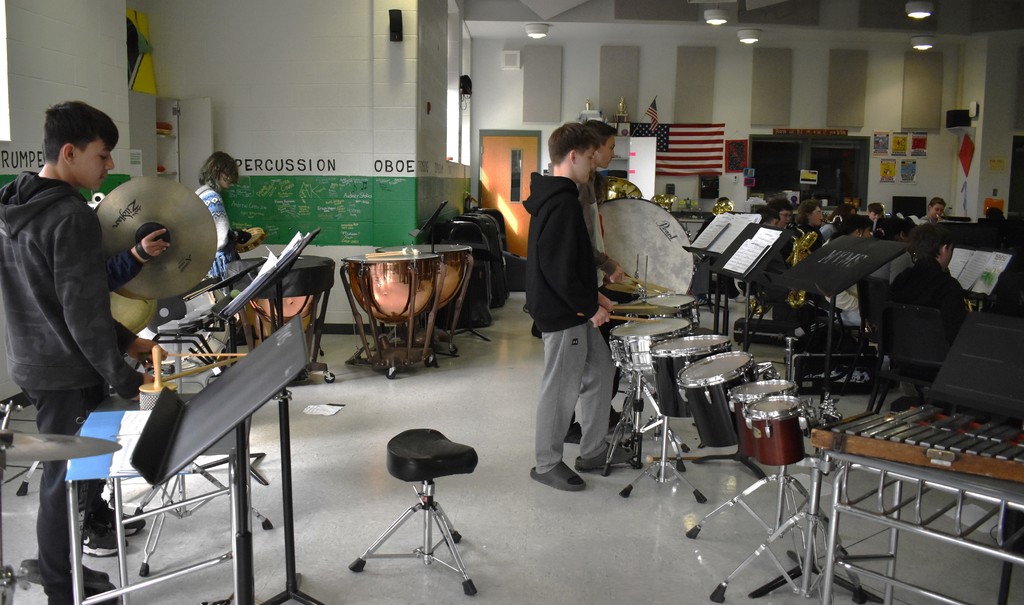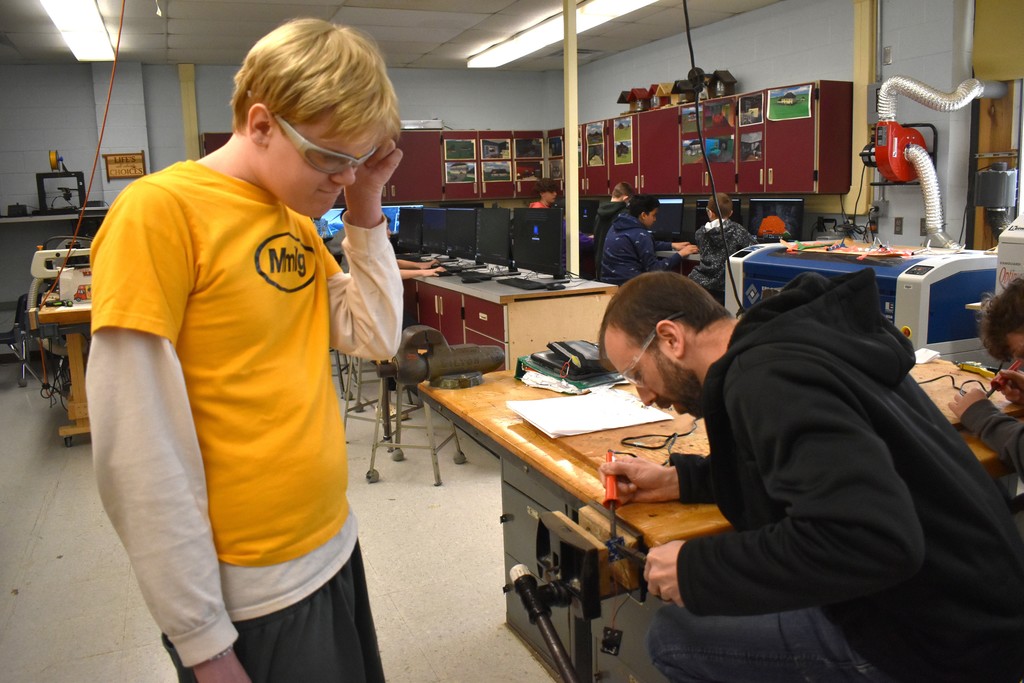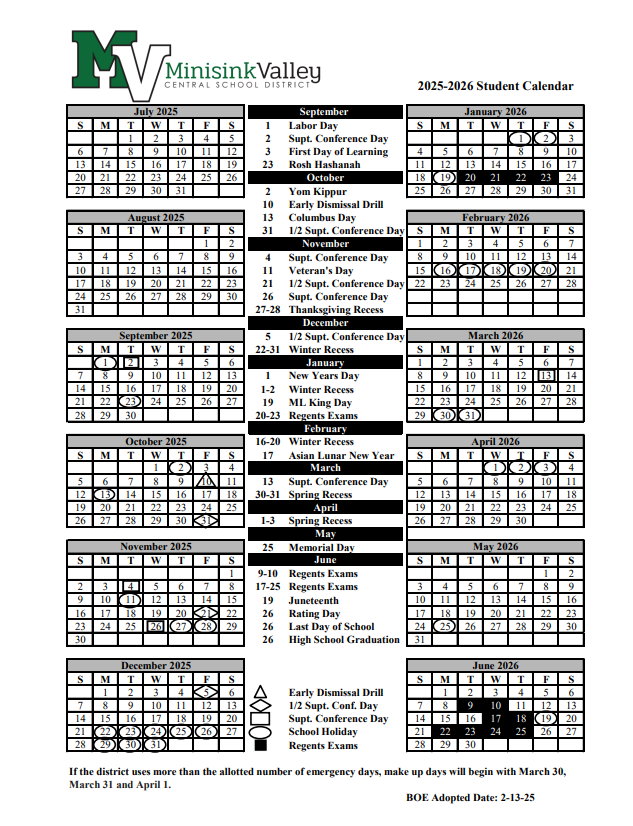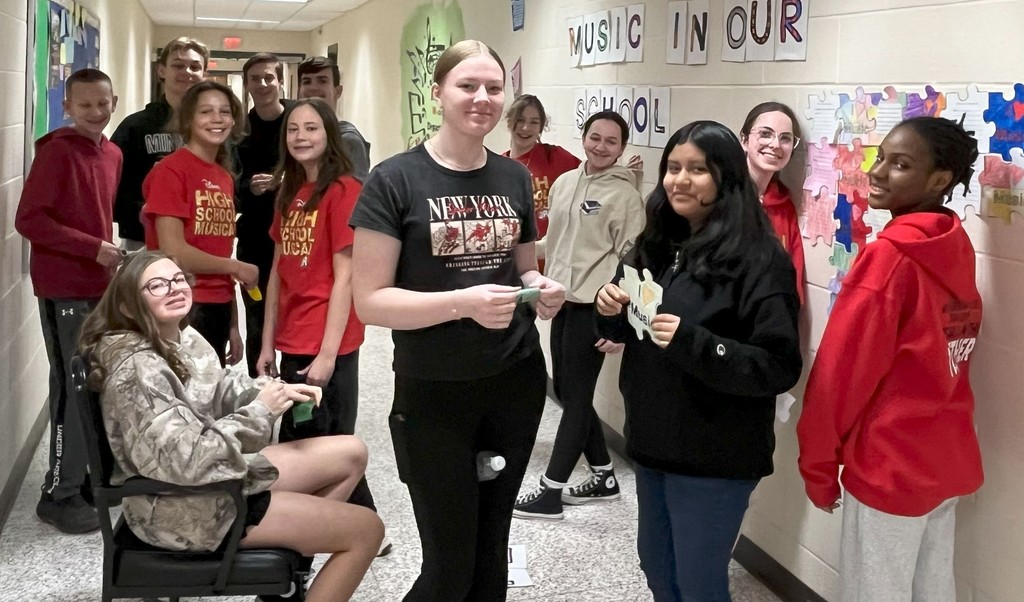There's a lot that goes on behind the scenes every concert season! Take a peek at Laura Hulle's eighth-grade band, which has been intensely practicing together to be ready for the Spring Concert! Every member in this ensemble is important and contributes to the overall band's success!








SOLDERING SUCCESS!
Rich Budd's seventh-grade technology students recently had the opportunity to work more on their soldering skills in a project which allowed them to make their own LED night lights!
Prior to this, students used a wiring diagram to properly arrange the components on the circuit board. The Night Light kit uses a photocell to automatically turn on a super bright LED as the room darkens and turns off the LED as the room lightens. Now, they have an extra light to make their favorite "dark" rooms a bit more brighter!






Reminder: The 2025-26 student calendar has been available for everyone's use!

Come play for a chance to support Middle School students, win a great bag and complete your Spring fashionista look!
The Middle School PTO’s Designer Bag Bingo Fundraiser will be held on Saturday, May 3! It’ll be a great evening filled with lots of ways to win: A Tricky Tray, 50/50 and Lottery Apron raffles along with great door prizes and more! Tickets are $45 each.
The event will take place at the Holy Cross Church Parish Center in Middletown, with doors opening at 5 p.m. and calling starting at 6:30 p.m. THIS EVENT WILL SELL OUT, so don’t miss out! Thanks for sharing!
Purchase tickets at: //www.eventbrite.com/e/minisink-valley-middle-school-pto-pocketbook-bingo-tickets-1314103201049?aff=oddtdtcreator

Jamie Gallo’s eighth-grade ELA students, like their peers in other classes, have been reading Thanhhà Lai’s “Inside Out and Back Again,” the story of the story of 10-year-old Hà, who flees Saigon with her family as refugees to America after the fall of Saigon in 1975, and their journey to start a new life in Alabama, facing both kindness and challenges.
This story involves many connections including experiencing grief and healing, challenges and resilience, adjusting to change and finding support, searching for identity and also finding strength. Despite the hardships, Hà and her family find strength in their bonds with each other and in the support of their new community.
In this story, Hà planted a papaya tree in Vietnam, which is her favorite fruit. As part of their studies, students learned the papaya tree, which grew from a seed, and what that symbolized and how of her this symbolism can be aligned with them as well:
•Fleeing South Vietnam:
The papaya tree's growth and the papayas themselves can also be seen as a symbol of Hà's relatively happy childhood in Vietnam being cut short, as she is forced to flee with her family.
•Hà's Personal Growth:
The papaya tree's rapid growth, from a small seed to a large tree bearing fruit, mirrors Hà's own journey from childhood to adolescence and her experiences as a refugee.
•Symbol of Change:
The papaya tree's growth from a seed to a fruit-bearing tree represents the transformative journey Hà undergoes, from a carefree life in Vietnam to the challenges and opportunities of a new life in America.
•Resilience and strength:
Thriving (tree and main character) despite challenging circumstances.
As a sweet, tasty and healthy way to conclude some of their work, students enjoyed taking part in a fruit mini-buffet, where they shared and discussed their own favorite fruit, childhood memories involving fruits they like or don't like and specifically why a particular fruit is their favorite. What an innovative to make connections to literature!






The Girls Lacrosse Program is off to a fabulous start!
Varsity Assistant Rory Boice reports that the Varsity and Junior Varsity teams’ recent games against Pine Bush ended with the Varsity team beating Pine Bush in a 17-10 final! The team created an offensive onslaught that Pine Bush had difficulty containing!
“The team left it all on the field,” Varsity Head Coach Jessica Gurrieri said. “It was a great day!”
Additionally, the Junior Varsity team ran away in their Pine Bush game, besting that Junior Varsity team which beat them the last two consecutive in a 20-2 final. Junior Varsity Coach Samantha Woodward’s squad was unselfish with the ball offensively and stingy on defense, as they displayed their skills.
To top things off, the Modified team beat Warwick in an 8-7 final!
“We demonstrated excellent ball movement, control, teamwork and communication,” added Modified Coach Rachael Moran.





Kaylin Morran’s sixth-grade art students recently took a hands-on approach to learning the elements of art!
Using 3D geometric and organic shapes students were challenged to make animals, foods and sports equipment. Then, as groups, they were tasked with building the tallest structure. This required students to experiment with balance and stability and they quickly learned they needed a base and couldn’t just build up!
Students figured it out and the tallest structure was over 30 inches!
Organic shapes contrast with geometric shapes, which have well-defined and regular attributes. These fluid and expressive forms add a sense of natural beauty and spontaneity to artistic compositions. These artistic shapes play a vital role in the world of art and design.




Ashley Hamilton’s and Bridget O’Mara-Green’s eighth-grade math classes have been studying the Pythagorean Theorem in class. Do you remember this: The Pythagorean theorem is the well-known geometric theorem that says the sum of the squares on the legs of a right triangle is equal to the square on the hypotenuse (the side opposite the right angle)—or, in familiar algebraic notation, a2 + b2 = c2.
As a final project to conclude their learning, students combined art with math and created and designed their own Pythagorean spirals! These are geometric patterns that use the principles of the Pythagorean theorem to generate spirals, which are created by successively drawing squares with side lengths that correspond to the sum of the squares of the previous two side lengths. This relationship follows the formula from the Pythagorean theorem.
Pythagorean spirals appear in art and even everyday life as a way to integrate mathematical elegance into visual design. This can be seen in abstract art, architecture, mosaic and tile patterns, digital and computational art, and even sculpture and installation art. The spirals combine the logical, structured world of math with the creative, expressive world of art, offering an aesthetic that is both ordered and visually dynamic.
•In mathematics, a theorem is a statement that has been proven to be true, based on previously established facts or axioms, using logical reasoning and mathematical operations.
•A Pythagorean spiral is also known as a spiral of Theodorus, or square root spiral, and was named after Greek mathematician Theodorus of Cyrene.
•Creativity plays a vital role in mathematical thought by allowing individuals to approach problems and concepts from unique perspectives. It fuels exploration, drives innovation, and helps mathematicians develop new tools, models, and methods. By blending logical reasoning with creative insight, mathematics evolves and continues to impact both abstract theory and practical applications.







Sixth-graders recently completed a creative and innovative 3-D geography project tied to their continued studies on ancient Greece!
The 6th grade teaching team led students on this project, requiring them to create a 3-D map of ancient Greece using supplies they contributed in addition to donations from their families and teachers.
But equally important was that the group project also introduced them to group project work and the different roles that a person could be assigned to when working in a group. As they advance to higher grade levels, there’s more opportunities and requirements for group work, so this project further reinforces why working well with others is a key to both individual and group success.
Each group was required to assign roles such as the label maker (creates the label flags, accurately places them on the map, and makes sure they are bold and legible); sculptor (uses the clay to sculpt the landforms and accurately represents the islands, seas, mountains, etc.; painter (correctly paints the map using the key and adds detail to each landform); cartographer (creates the scale, key, and compass rose and makes sure that others are following the key); and project manager (makes sure everyone has materials, fact checks the project, and keeps everyone on task).
Students were assigned tasks to be completed each day over a 3-day period. By the end of the project, they were able to identify Crete, Athens, Sparta, Mt. Olympus, Peloponnesus, Ionian Sea, Mediterranean Sea, Aegean Sea, Rhodes, Turkey, Albania, Macedonia, Bulgaria, Ionia, Corinth and Delphi. Students were also expected to rate their group on productivity and contribution and provide both positive and negative feedback.
Students were graded on accuracy, appearance, parts of a map and effort. Overall, the students demonstrated effective brainstorming skills, productive collaboration, and successful knowledge of the geography of Greece. Each map displayed creativity and uniqueness!
THANK YOU to everyone who donated clay/dough, toothpicks, Post-it notes, paint, cardboard and more to make this project a reality!










Kudos to members of the Middle School Builders Club, which recently created 25 craft kits for children who may need a little uplifting during healthcare visits!
Each kit contains a blank booklet, coloring pages, stickers, crayons and a message from our club members. These kits are being sent to Garnet Medical Center in Middletown.
“Our members were very excited for this project and voiced their hope that we can do it multiple times a year,” said advisor Lauren Pullen. We hope we can reach as many children in need as possible. We’re so proud of the generosity that our members show.”



Today, April 1, Middle School eighth-graders attended a special “Break the Cycle” assembly which featured keynote presenters Pat and AnneMarie D’Aliso, who were Minisink Valley residents and have spoken to students here in recent years, as well as other speakers.
Their son Patrick died by suicide at age 16 and Mr. and Mrs. D’Aliso have become important champions about undiagnosed depression and paying attention to anything that may seem out of sorts in the lives of young people. Mr. and Mrs. D’Aliso do this because they hope by telling their story, they may help to save the life of someone in crisis. We remain grateful for their ongoing interest in speaking to our students and thank them and the other speakers who were part of this important presentation.
This topic is understandably a sensitive one, but one which we feel is very important to share to our students. Eighth-grade parents/guardians, to follow-up on a note Principal Michael Larsen sent to you in late March, please remind your child know you know that this assembly took place today and continue the important conversation of if he or she needs help for any reason, we are here to provide all the assistance we can.
As a reminder, the middle school counseling team is always available to our students for assistance they may need on any topic or issue of concern. Likewise, if you have any concerns about your child’s mental health and wellbeing, please reach out to us. We are here to help.
To learn more: https://www.breakingthecycle.com/





Sixth-grade teachers Nicole Lee’s, Jaclyn Lockett’s and Andrea Ferguson’s recent science activities, labs and experiments have incorporated a lot of fun in the learning process!
Students interacted with a plasma ball, ate hydrogen marshmallows (for their nuclear fusion lab) and energy ice pops, used “Think Pair Share” cards and whiteboards to ask their own kinetic/potential examples, in addition to a group trivia challenge, a “We've Got Energy” posters, a “Twist-o-Matic Challenge” with a partner using a rubber band, scissors, and an index card to try and create kinetic energy.
Whew! That’s a lot of creative learning! But wait, there’s more! Activities also included a teacher swap with colleague Paul John DeStefano, who visited their classrooms to present a mini-lesson on electrostatic!
Mr. DeStefano loaned the teachers his electrostatic generators, where the students were actually shocked (safely, if they wanted to) and could see how energy passes!
Making science fun enhances the learning process by boosting engagement, fostering a love for learning, and promoting deeper understanding through hands-on experiences that encourage exploration and critical thinking.








March is “Music in our Schools Month” and the Middle School Music Department has been busy sharing music education facts (and some jokes) to students! This year’s theme is “United through Music.” To represent this theme, band, chorus and general music students made puzzle pieces which express their love for music. This display can be seen outside of the music suite!
•Music is a natural stress reliever, which is good for blood pressure and heart rate. Studying music helps people better express their emotions and manage anxiety. Musicians are also using their muscles when playing an instrument because they’re using their arm, core, and back muscles. Vocalists and instrumentalists also build stronger lungs.
•Like sports, music helps improve hand-eye coordination and also helps children develop their small motor skills. Music also promotes teamwork. Whether playing in a band or singing in a choir, teaches people how to work and get along with each other.




FORGET MARCH MADNESS, IT’S 'MOZZ' MADNESS!
We love, love, love it when members of the business community visit our schools to offer our students a memorable learning experience!
Meet Master Mozzarella Maker Gregory Lararia of Adams Fairacre Farms in Newburgh and Middletown! Mr. Lararia, who runs Adams’ mozzarella shops, visited all of Victoria Ingrassia’s eighth-grade FACS classes earlier this week to give students a tutorial on how to make fresh, homemade mozzarella!
He shared his “mozz mastery” with students, explaining and demonstrating the very simple process to make mozzarella using curds, milk, hot water, some salt with a mixing and stretching technique sprinkled in. Then, students made their own “mozz!” And, it was simply delicious!
Students had a great time with a great hands-on learning experience. Thank you, Mr. Lararia, we appreciate your time and interest in teaching our students!










Kristine Ostensen's eighth-grade classes recently completed a very “sweet” (and edible) DNA lab lesson!
Students created the DNA’s twisted helix by using mini marshmallows, toothpicks and Twizzlers. Then, they copied a DNA sequence and matched the nitrogenous base pairs to create a DNA model.
Once completed, students were able to twist their models into the double helix shape and, finally, they were able to devour their tasty lesson! What a fun and creative way to reinforce science terminology!
•DNA, or deoxyribonucleic acid, is the molecule that carries genetic information, like a blueprint for how a living thing is built and functions, and is found in the cells of all living organisms.
•DNA's "double helix" refers to its structure, a twisted ladder shape formed by two intertwined strands of nucleotides.
•A DNA sequence refers to the specific order of the four nucleotide bases (adenine, thymine, cytosine, and guanine, abbreviated as A, T, C, and G) that make up a DNA molecule, which carries the genetic instructions for an organism.
•In DNA, the nitrogenous base pairs are formed by adenine (A) always pairing with thymine (T), and guanine (G) always pairing with cytosine (C).







REMINDER: Minisink Valley has partnered with Paper, an online tutoring service, to provide students in Grades 6 through 12 with the ability to access live tutors seven days a week, 24 hours a day.
High School/Middle School students and family members have unlimited access to trained tutors so every student can ask questions, work through problems and grow their confidence at no cost to families.
Tutoring is available in English, Spanish, French and Mandarin in all core academic subjects: English Language Arts, Social Studies, Science, Math and World Languages.
https://www.minisink.com/page/paper-online-tutoring-for-grades-6-12?fbclid=IwY2xjawJJDWFleHRuA2FlbQIxMAABHdJK6iFFDUGVK-oZr5ygipsDug4I9iweQuDTE-JsvyDrqE0Axk-RLUL3JA_aem_nGURGwayPfeBYNaf7OskmA

EXTRA! EXTRA! The March edition of Middle School's Minisink Messenger is hot off the presses! To read, please click here:
https://docs.google.com/document/d/1q5hDkMUUigTyDepo4Gb75gTtjrV3RQnR_K1gJ-WVJyg/edit?fbclid=IwY2xjawJI5uxleHRuA2FlbQIxMQABHZ64GVOKhIsYXdXrhk5DIRoXEzLgWHG04tDsEtsRpK35hzgqnU_A4CtGlA_aem_nVH7ggZ0m9d8OtCkZrPqqw&tab=t.0

ARE YOU READY? IS YOUR BRACKET SET? MARCH MADNESS officially begins with a 6:40 p.m. tip off tonight when the St. Francis Red Flash meet Alabama State in the first of two “First Four” games.
But! Middle School Spanish classes have just completed their own MARCH MADNESS- type tournament today, March 18, with Spanish music called "Locura de Marzo!"
“Locura de Marzo” is a Spanish music tournament created by a group of Spanish teachers that takes place every March. It's similar to March Madness, but instead of college basketball teams, it's Spanish songs! This year, there are more than 215,451 students in 1,350 schools in all 50 states and 13 other countries, including the Middle School, who participated!
How it works:
•Spanish teachers around the world select 16 songs
•Each day, two songs compete against each other
•Students listen to the songs and vote for their favorite
•The winning song moves on to the next round, and the losing song is eliminated
At the Middle School, students all selected the songs that they liked in their own brackets and whoever had the most correct choices at the end of all of the rounds wins! Felicidades a los ganadores del soporte Maggie Pason y Lennox Addo!
What a great way to expose students to the Spanish language through music! Plus, “Locura de Marzo” also exposes students to new music styles and artists; helps engage students with real-world content; and helps students develop at cultural connection to different styles music!

ST. PATRICK’S DAY FUN: MAGICALLY DELICIOUS MATH RATIOS!
Jacklyn Lockett’s sixth-grade math students completed some St. Patrick’s Day-centric math work focusing on ratios using Lucky Charms cereal!
Students categorized the cereal’s marshmallow bits by shape and then wrote ratios comparing the different types of marshmallow bits to other types (a part-to-part) ratio. Later then wrote “part-to-whole” ratios… and then ate the marshmallow bits!
•Part-to-part ratios demonstrate the relationship between two distinct groups or entities, allowing for comparisons and understanding of their relative proportions, which is crucial in various fields like math, statistics and real-world applications.
•Part-to-whole ratios express the relationship between a specific part and the entire whole, providing a clear understanding of proportions and facilitating comparisons, analysis, and visualization of data across various fields.







PI/π MATH ‘LAB!’
Kristine Kidney’s Middle School math students completed a special “math lab” on March 14, to mark Pi/π Day! It was a fun and different way to apply students' knowledge of the ratio of the circumference of a circle to its diameter!
Students measured various circular items and recorded their circumference and diameter. Then, they found the averages of these ratios, which should have equaled 3.14!
•Pi is the ratio of the circumference of a circle to its diameter. It's an irrational, which means it doesn't repeat.
•In 250 BCE, Archimedes of Syracuse created the first algorithm to calculate pi.
•He used the Pythagorean Theorem and the areas of polygons inscribed within a circle to more accurately show pi, which is between 3 1/7 and 3 10/71.
•In 1706, Welsh mathematician William Jones used the Greek letter “π” to represent pi.
•Swiss mathematician Leonhard Euler popularized the use of the symbol in 1737








